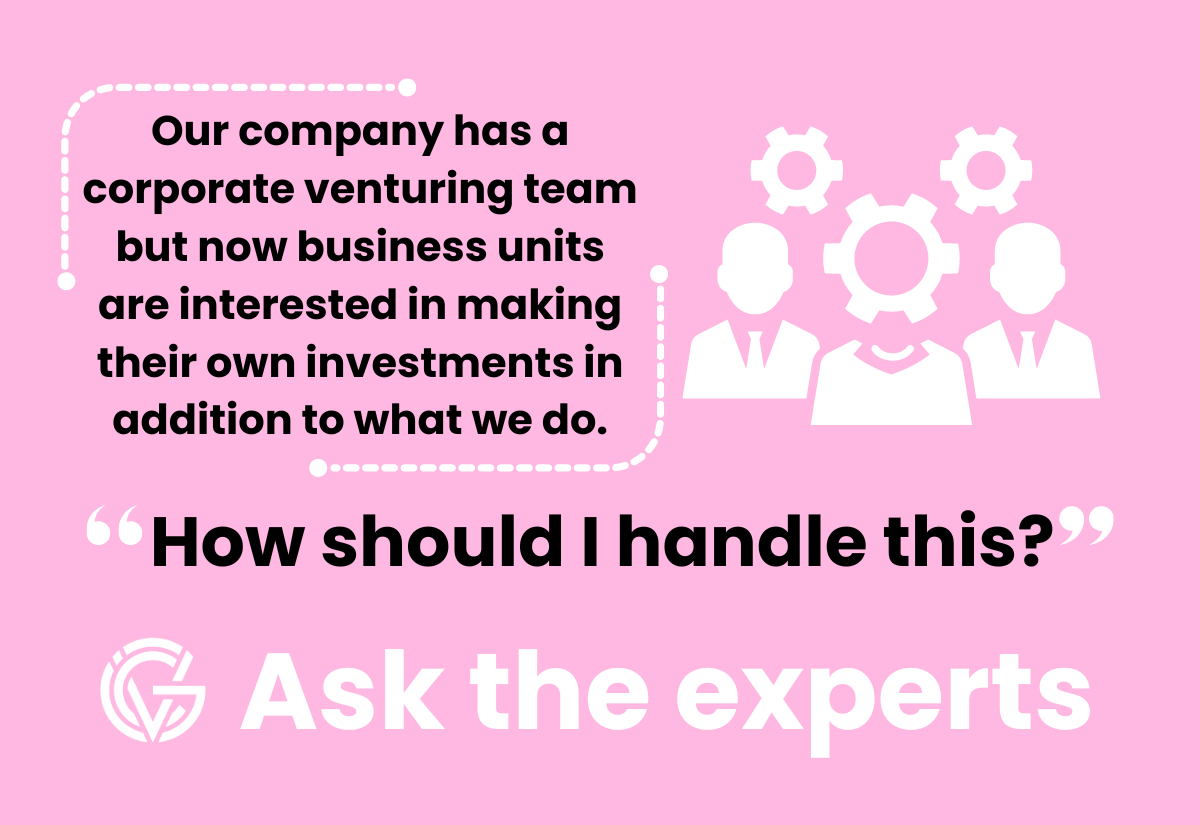Our monthly advice column in which an expert panel gives advice on common problems in corporate venturing.

This is a monthly column in which readers can ask our network of experienced corporate venturing professionals about how to handle the common dilemmas of CVC practice.
If you would like to submit a question email us here.
The question:
“We recently invested in a potentially game-changing startup but are struggling to get the relevant business unit to engage. What should we do?”
The expert views:

Many factors go into business collaboration and, while uncommon, situations do occur where initial excitement from the business unit before the investment does not translate into immediate engagement afterward. This shift in attitude could stem from various factors, such as differing priorities, resource constraints, or uncertainty about the next steps. Additionally, the question of who takes the first step in initiating collaboration can sometimes become a stumbling block.
In most situations, the CVC unit can encourage and support the engagement but not force it to happen. If the startup is very keen to engage with the business unit, enabling direct communication between the startup and the business unit before finalising the investment can help allow both parties to gain insight into each other’s perspectives, expectations, and capabilities.
“It is important that the CVC unit does not overpromise immediate engagement from the business unit.”
Also, setting realistic expectations with both the portfolio company and the business unit, and clarifying roles and responsibilities can help manage any discrepancies in readiness to engage.
It is important that the CVC unit does not overpromise outcomes or immediate engagement from the business unit. Transparency regarding the long-term strategic vision of the CVC unit versus the short-term objectives of the business group is essential. By aligning these perspectives, the startup can better understand the dynamics at play and what to expect from the engagement.

Make sure you are not just throwing things over the wall. CVC teams are more likely to run into “Not invented here”-syndrome or prioritisation challenges when they are not seen as trusted advisors and key contributors to corporate or business unit innovation strategy. Investments should reflect an end-to-end perspective.
This includes making sure that:
• Investment themes are aligned with business unit innovation priorities and problem sets
• Deal due diligence reflects insight from business units and the CVC platform team which helps make the connections between the startup and the parent company. But make sure that the due diligence you do doesn’t get completely buried by this side.
• Investment decisions come with a plan for how the parent company will engage and add value to startup
• The business unit is ‘wired’ to engage with startups, including knowing how to decide when the time is ripe to work together.
CVC investors should remember that if you are not part of the process, you are part of the problem.
If you would like more guidance on issues like this, the GCV Institute runs professional training courses for corporate investors. Find out more here.

Do not force their hand. Even with pressure from the top you will not get excitement or sustainable interest from the unit.
Do a reality check on how mature the startup’s product currently is. Is it already a good fit for direct corporate use? If not, no problem, the CVC can help bridge the time it will take to get it ready for corporate engagement.
If you are convinced that it is game-changing, invest as the CVC unit (as this is also your mandate) and invest in follow-on rounds if the startup performs well. You can make a lot of money as financial return, even if the operational unit does not engage (as the CVC business model is flexible in this regard).
“Share successes of the startup as they take on new clients.”
Share successes of the startup as they take on new clients. Share this with not only the leadership of the operational unit, but also with middle management and employees of the unit.
Inform the operational unit and M&A team early about your exit timing — ie, before the process is started — to give them enough time to think about a possible acquisition. But always keep Chinese walls in place, so make sure you connect the startup with the M&A team directly and do not share confidential data.

Last month’s question:
What to do when business units want to invest, too
Liz Arrington from the GCV Institute, James Loftus from PayPal Ventures and David Stevenson from MSD Global Health Innovation Fund share advice.
Would you like to be on our panel of experts? We are building a group of experienced people we can tap for answers to these reader questions. If you’d be happy to contribute your advice, please get in touch!

Maija Palmer
Maija Palmer is editor of Global Venturing and puts together the weekly email newsletter (sign up here for free).








